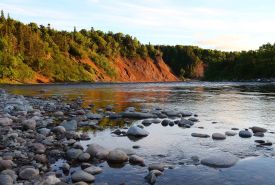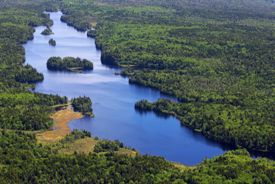Climate change plan: A focus on habitat conservation

Crabbes River, NL (Photo by Mike Dembeck)
With the attention of the world on the Paris COP21 climate change meetings, the chance of a new agreement to control greenhouse gases (GHG) seems higher than at any time since Kyoto more than a decade ago. Emission reduction targets, new green technologies and international cooperation will all play their role, but a uniquely Canadian proposition should not be lost in the mix.
Canada has a rare opportunity, indeed an obligation, to be a world leader in the conservation of natural habitat and by doing so to contribute directly to the fight against climate change.
Unlike many other nations at the Paris talks, much of our natural habitat is still intact. Our globally significant natural areas not only conserve our biodiversity, they store enormous amounts of carbon. With more than a quarter of the world’s northern forests and a quarter of its wetlands, Canada is home to extensive natural systems that have measurable impacts on containing the planet’s rising CO₂ levels.
Conservation of our natural ecosystems is integral to any effective Canadian strategy to slow climate change and to mitigate its effects.
Significant scientific evidence shows that the destruction and clearing of forests, grasslands and wetlands, in addition to the burning of fossil fuels, has resulted in a substantial increase in greenhouse gas concentrations in the earth’s atmosphere. In fact, the Intergovernmental Panel on Climate Change estimates that approximately 30 per cent of the total historic human-induced increase in GHG emissions is the result of deforestation and forest disturbance, and continues to account for approximately 18 per cent of annual GHG emissions.
A conserved forest not only avoids the release of GHGs, it continues to sequester carbon over its lifetime. Canada’s boreal forest, for example, stores about 71 billion tonnes of carbon in the forest ecosystems and 138 billion tonnes in the peat land ecosystems.

Fishing Lake was purchased for permanent conservation by NCC (Photo by Mike Dembeck)
Canada’s natural ecosystems also provide natural buffers against the effects of climate change. Our forests and wetlands are net carbon sinks. They cool the planet, store carbon, ensure a supply of clean water, and mitigate flood risk, among other benefits.
When it comes to nature, Canada already punches above its weight. Forests, wetlands and grasslands store more terrestrial carbon than any other ecosystems on Earth, and in Canada we still have an opportunity to ensure our systems remain intact. Conservation is the key.
Currently, Canada has committed to protecting 17 per cent of our terrestrial habitat by 2020 — an area greater in size than France, Germany, the United Kingdom and Spain combined. However, scientists now recommend at least 25 per cent of the landscape needs to be conserved for the continued health of our planet. Canada can be number one in the world in land conservation, but that means treating our current commitment of conserving 17 per cent of our terrestrial habitat as the starting point; not the finish line.
As the attention of the world focuses on our collective response to climate change, the role of nature and the conservation of natural systems should be part of our overall strategy. Canadians can be proud of our commitment to protect our natural habitats for the measurable effects they have on reducing CO₂. But it is possible to set new goals for the conservation of our forests, wetlands and grasslands that go beyond our existing international commitments. Let’s continue to engage all levels of government, Indigenous peoples, industry and the non-profit sector to help develop robust, collaborative conservation initiatives.
Canada is uniquely positioned to assume a global leadership role on the environment, both in substance and reputation. Let’s remember the role nature conservation plays in the battle to slow climate change and to mitigate its effects. We will be judged not only by the changes we make en route to a low carbon economy, but also by what we choose to keep — the natural spaces that sustain Canadians and the world.


